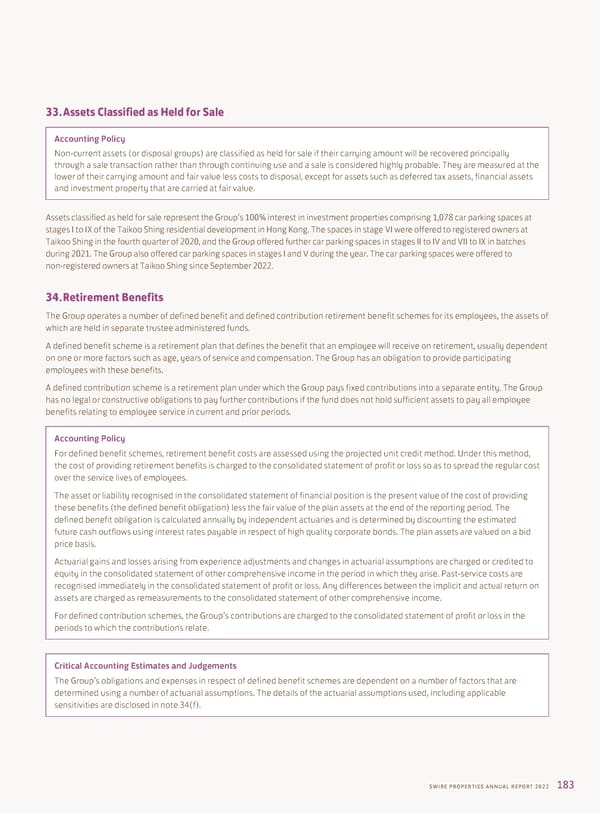33. Assets Classified as Held for Sale Accounting Policy Non-current assets (or disposal groups) are classified as held for sale if their carrying amount will be recovered principally through a sale transaction rather than through continuing use and a sale is considered highly probable. They are measured at the lower of their carrying amount and fair value less costs to disposal, except for assets such as deferred tax assets, financial assets and investment property that are carried at fair value. Assets classified as held for sale represent the Group’s 100% interest in investment properties comprising 1,078 car parking spaces at stages I to IX of the Taikoo Shing residential development in Hong Kong. The spaces in stage VI were offered to registered owners at Taikoo Shing in the fourth quarter of 2020, and the Group offered further car parking spaces in stages II to IV and VII to IX in batches during 2021. The Group also offered car parking spaces in stages I and V during the year. The car parking spaces were offered to non-registered owners at Taikoo Shing since September 2022. 34. Retirement Benefits The Group operates a number of defined benefit and defined contribution retirement benefit schemes for its employees, the assets of which are held in separate trustee administered funds. A defined benefit scheme is a retirement plan that defines the benefit that an employee will receive on retirement, usually dependent on one or more factors such as age, years of service and compensation. The Group has an obligation to provide participating employees with these benefits. A defined contribution scheme is a retirement plan under which the Group pays fixed contributions into a separate entity. The Group has no legal or constructive obligations to pay further contributions if the fund does not hold sufficient assets to pay all employee benefits relating to employee service in current and prior periods. Accounting Policy For defined benefit schemes, retirement benefit costs are assessed using the projected unit credit method. Under this method, the cost of providing retirement benefits is charged to the consolidated statement of profit or loss so as to spread the regular cost over the service lives of employees. The asset or liability recognised in the consolidated statement of financial position is the present value of the cost of providing these benefits (the defined benefit obligation) less the fair value of the plan assets at the end of the reporting period. The defined benefit obligation is calculated annually by independent actuaries and is determined by discounting the estimated future cash outflows using interest rates payable in respect of high quality corporate bonds. The plan assets are valued on a bid price basis. Actuarial gains and losses arising from experience adjustments and changes in actuarial assumptions are charged or credited to equity in the consolidated statement of other comprehensive income in the period in which they arise. Past-service costs are recognised immediately in the consolidated statement of profit or loss. Any differences between the implicit and actual return on assets are charged as remeasurements to the consolidated statement of other comprehensive income. For defined contribution schemes, the Group’s contributions are charged to the consolidated statement of profit or loss in the periods to which the contributions relate. Critical Accounting Estimates and Judgements The Group’s obligations and expenses in respect of defined benefit schemes are dependent on a number of factors that are determined using a number of actuarial assumptions. The details of the actuarial assumptions used, including applicable sensitivities are disclosed in note 34(f). SWIRE PROPERTIES ANNUAL REPORT 2022 183
 Annual Report 2022 Page 184 Page 186
Annual Report 2022 Page 184 Page 186